A New Asynchronous RTK Method to Mitigate Base Station Observation Outages
Abstract
1. Introduction
2. Methodology
2.1. Real-Time Kinematics (RTK) and Asynchronous Real-Time Kinematics (ARTK)
2.2. Asynchronous Ionospheric Delay
2.3. Asynchronous Residual Error
2.4. New ARTK Strategy
3. Experimental Validations
3.1. Static Positioning Experiment
3.2. Dynamic Positioning Experiment
3.3. Results for Different Short Baseline Lengths
4. Discussion and Conclusions
Author Contributions
Funding
Conflicts of Interest
References
- Gili, J.; Corominas, J.; Rius, J. Using global positioning system techniques in landslide monitoring. Eng. Geol. 2000, 55, 167–192. [Google Scholar] [CrossRef]
- Wang, G. GPS Landslide monitoring: Single base vs. network solutions—A case study based on the Puerto Rico and Virgin Islands Permanent GPS Network. J. Geod. Sci. 2011, 1, 191–203. [Google Scholar] [CrossRef]
- Huang, G.; Du, Y.; Meng, L.; Huang, G.; Wang, J.; Han, J. Application performance analysis of three GNSS precise positioning technology in landslide monitoring. In China Satellite Navigation Conference (CSNC) 2017 Proceedings; Sun, J., Liu, J., Yang, Y., Fan, S., Yu, W., Eds.; Springer: Singapore, 2017; Volume I, pp. 139–150. [Google Scholar]
- Kato, T.; Terada, Y.; Masao, K. Real-time observation of tsunami by RTK-GPS. Earth Planets Space 2000, 52, 841–845. [Google Scholar] [CrossRef]
- Kelecy, M.; Born, H.; Parke, E.; Rocken, C. Precise mean sea level measurements using the global positioning system. J. Geophys. Res. 1994, 99, 7951. [Google Scholar] [CrossRef]
- Wang, G. Kinematics of the Cerca del Cielo, Puerto Rico landslide derived from GPS observations. Landslides 2012, 9, 117–130. [Google Scholar] [CrossRef]
- Awange, J.L. Environmental Monitoring Using GNSS: Global Navigation Satellite Systems; Springer: Berlin, Germany, 2012. [Google Scholar]
- Wang, G.; Bao, Y.; Cuddus, Y.; Jia, X.; Serna, J., Jr.; Jing, Q. A methodology to derive precise landslide displacement time series from continuous GPS observations in tectonically active and cold regions: A case study in Alaska. Nat. Hazards 2015, 77, 1939–1961. [Google Scholar] [CrossRef]
- Teunissen, P.J.G.; De Jonge, P.J.; Tiberius, C.C. The least-squares ambiguity decorrelation adjustment: Its performance on short GPS baselines and short observation spans. J. Geod. 1997, 71, 589–602. [Google Scholar] [CrossRef]
- Bellone, T.; Dabove, P.; Manzino, A.M.; Taglioretti, C. Real-time monitoring for fast deformations using GNSS low-cost receivers. Geomat. Nat. Hazards Risk 2014, 7, 458–470. [Google Scholar] [CrossRef]
- Michaud, S.; Santerre, R. Time-relative positioning with a single civil GPS receiver. GPS Solut. 2001, 5, 71–77. [Google Scholar] [CrossRef]
- Wang, H.; Ou, J.; Yuan, Y. Strategy of data processing for GPS rover and reference receivers using different sampling rates. IEEE Trans. Geosci. Remote Sens. 2011, 49, 1144–1149. [Google Scholar] [CrossRef]
- Zhang, L.; Lv, H.; Wang, D.; Hou, Y.; Jie, W. Asynchronous RTK precise DGNSS positioning method for deriving a low-latency high-rate output. J. Geod. 2015, 89, 641–653. [Google Scholar] [CrossRef]
- Lawrence, D.G. Reference Carrier Phase Prediction for Kinematic GPS. U.S. Patent 5,903,236, 11 May 1999. [Google Scholar]
- Park, B.; Kee, C. The Compact Network RTK Method: An effective solution to reduce GNSS temporal and spatial decorrelation error. J. Navig. 2010, 63, 343–362. [Google Scholar] [CrossRef]
- Song, J. A New Approach of Latency Error Compensation. Using Compact RTK for GPS/GLONASS Signals. CGSIC 2017. September 25th, 2017. Available online: https://www.gps.gov/cgsic/meetings/2017/song.pdf (accessed on 1 August 2019).
- Huang, G.; Cui, B.B.; Zhang, Q.; Fu, W.; Li, P. An improved predicted model for BDS ultra-rapid satellite clock offsets. Remote Sens. 2018, 10, 60. [Google Scholar] [CrossRef]
- Xu, G.; Xu, Y. GPS: Theory, Algorithms and Applications; Springer: Berlin, Germany, 2016. [Google Scholar]
- Tu, R.; Zhang, R.; Lu, C.; Zhang, P.; Liu, J.; Lu, X. A unified model for BDS wide area and local area augmentation positioning based on raw observations. Sensors 2017, 17, 507. [Google Scholar] [CrossRef] [PubMed]
- Tu, R.; Lu, C.; Zhang, P.; Zhang, R.; Liu, J.; Lu, X. The study of BDS RTK algorithm based on zero-combined observations and ionosphere constraints. Adv. Space Res. 2017, 63, 2687–2695. [Google Scholar] [CrossRef]
- Ge, M.; Gendt, G.; Rothacher, M.; Shi, C.; Liu, J. Resolution of GPS carrier-phase ambiguities in precise point positioning (PPP) with daily observations. J. Geod. 2008, 82, 389–399. [Google Scholar] [CrossRef]
- Liu, Z.; Chen, W. Study of the ionospheric TEC rate in Hong Kong region and its GPS/GNSS application. In Proceedings of the International Technical Meeting on GNSS Global Navigation Satellite System—Innovation and Application, Beijing, China, 8–9 August 2009; pp. 129–137. [Google Scholar]
- Zhang, B.; Teunissen, P.J.G.; Yuan, Y.; Zhang, H.; Li, M. Joint estimation of vertical total electron content (VTEC) and satellite differential code biases (SDCBs) using low-cost receivers. J. Geod. 2018, 92, 401–413. [Google Scholar] [CrossRef]
- Zhang, B.; Teunissen, P.J.G.; Yuan, Y.; Zhang, H.; Li, M. A modified carrier-to-code leveling method for retrieving ionospheric observables and detecting short-term temporal variability of receiver differential code biases. J. Geod. 2018, 93, 19–28. [Google Scholar] [CrossRef]
- Zhang, B. Three methods to retrieve slant total electron content measurements from ground-based GPS receivers and performance assessment. Radio Sci. 2016, 51, 972–988. [Google Scholar] [CrossRef]
- Takasu, T.; Yasuda, A. Kalman-filter-based integer ambiguity resolution strategy for long-baseline RTK with ionosphere and troposphere estimation. In Proceedings of the International Technical Meeting of the Satellite Division of the Institute of Navigation, Portland, OR, USA, 21–24 September 2010; Volume 7672, pp. 161–171. [Google Scholar]
- Zhao, Q.; Sun, B.; Dai, Z.; Hu, Z.; Shi, C.; Liu, J. Real-time detection and repair of cycle slips in triple-frequency GNSS measurements. GPS Solut. 2014, 19, 381–391. [Google Scholar] [CrossRef]
- Cai, C.; Liu, Z.; Xia, P.; Dai, W. Cycle slip detection and repair for undifferenced GPS observations under high ionospheric activity. GPS Solut. 2013, 17, 247–260. [Google Scholar] [CrossRef]
- Huang, G.; Zhang, Q. Real-time estimation of satellite clock offset using adaptively robust Kalman filter with classified adaptive factors. GPS Solut. 2012, 16, 531–539. [Google Scholar] [CrossRef]
- Huang, G.; Zhang, Q.; Xu, G.C. Real-time clock offset prediction with an improved model. GPS Solut. 2014, 18, 95–104. [Google Scholar] [CrossRef]
- Salyani, M. Dynamic accuracy of GPS receivers in citrus orchards. Appl. Eng. Agric. 2008, 24, 861–868. [Google Scholar]
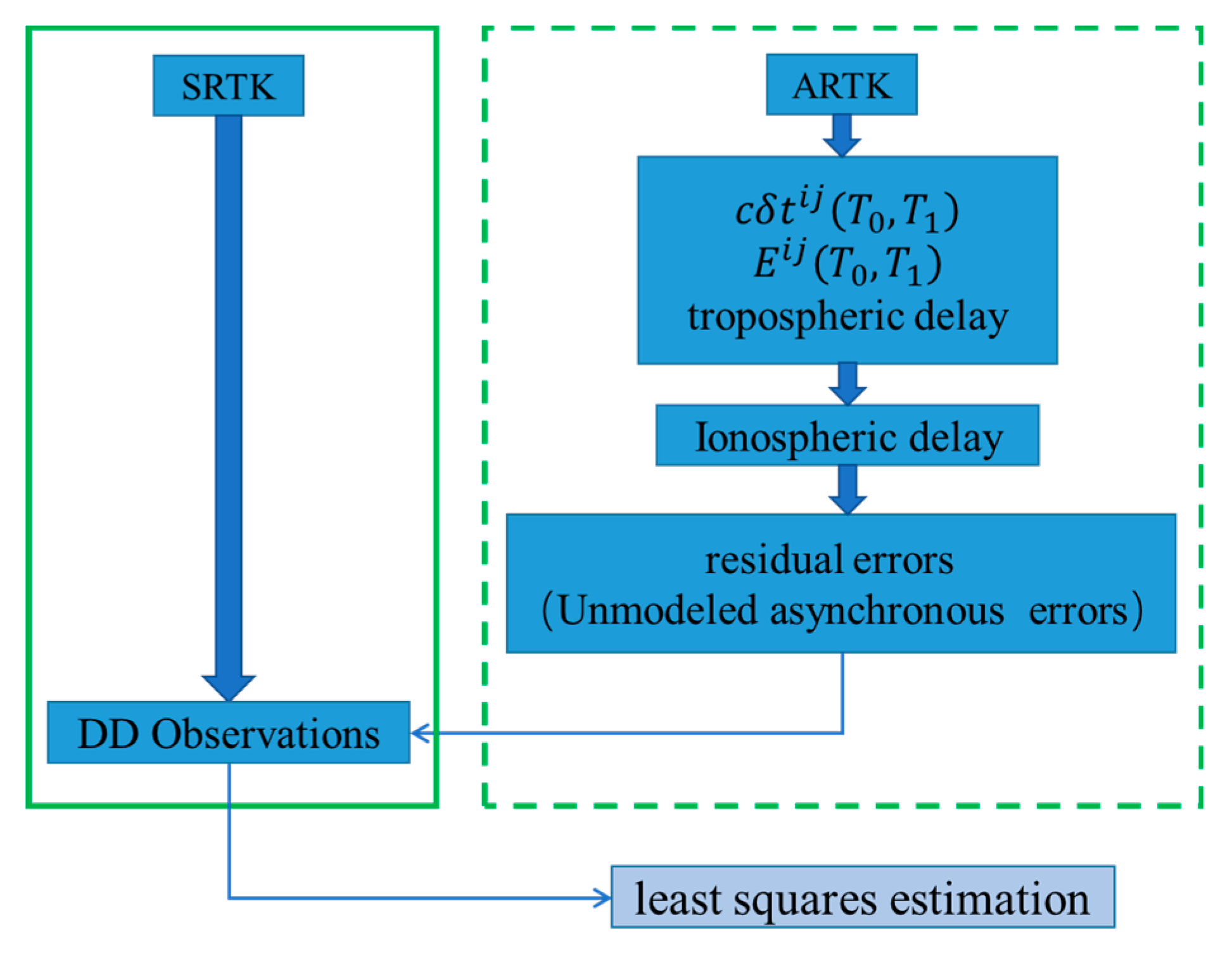
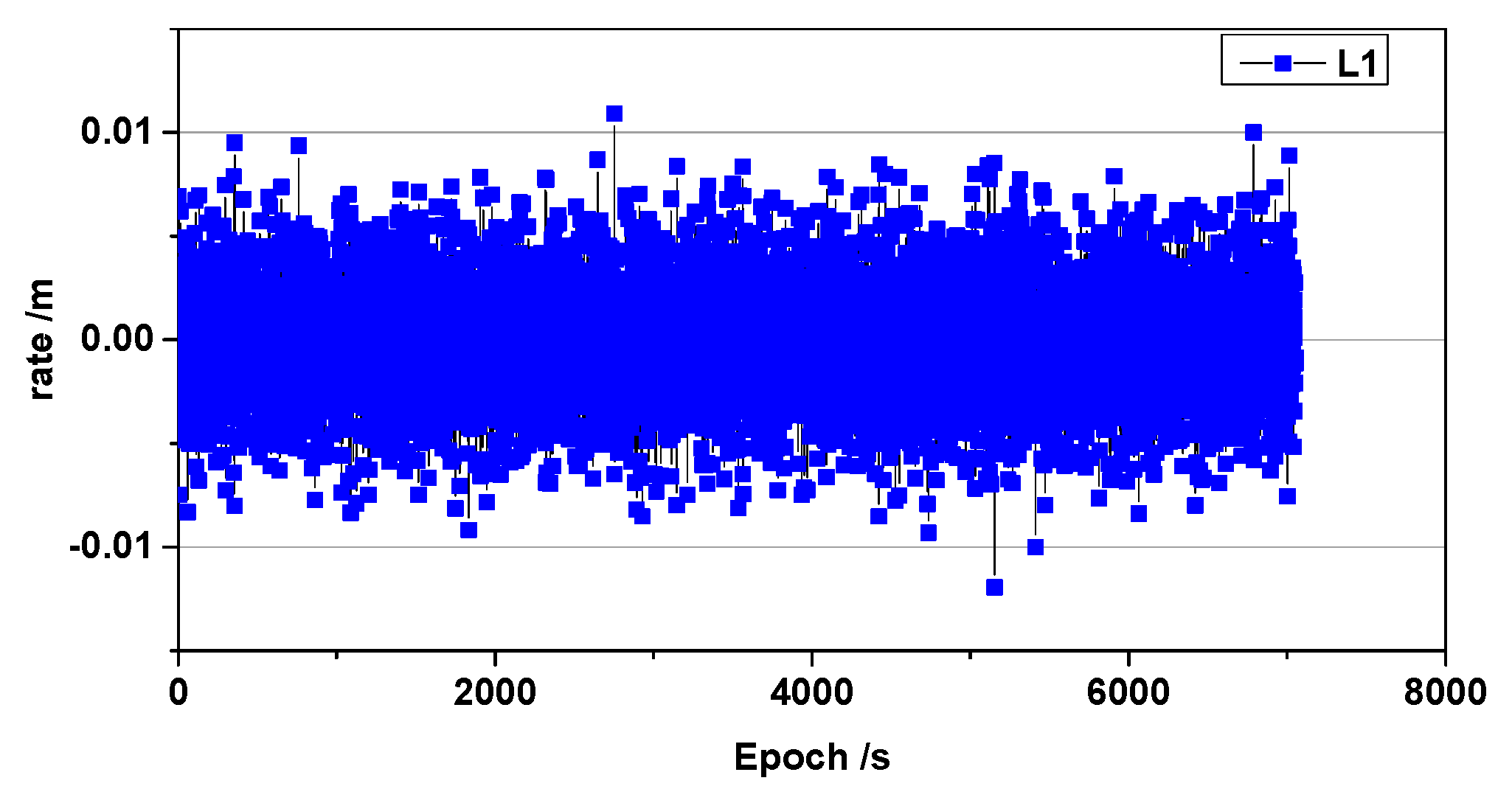
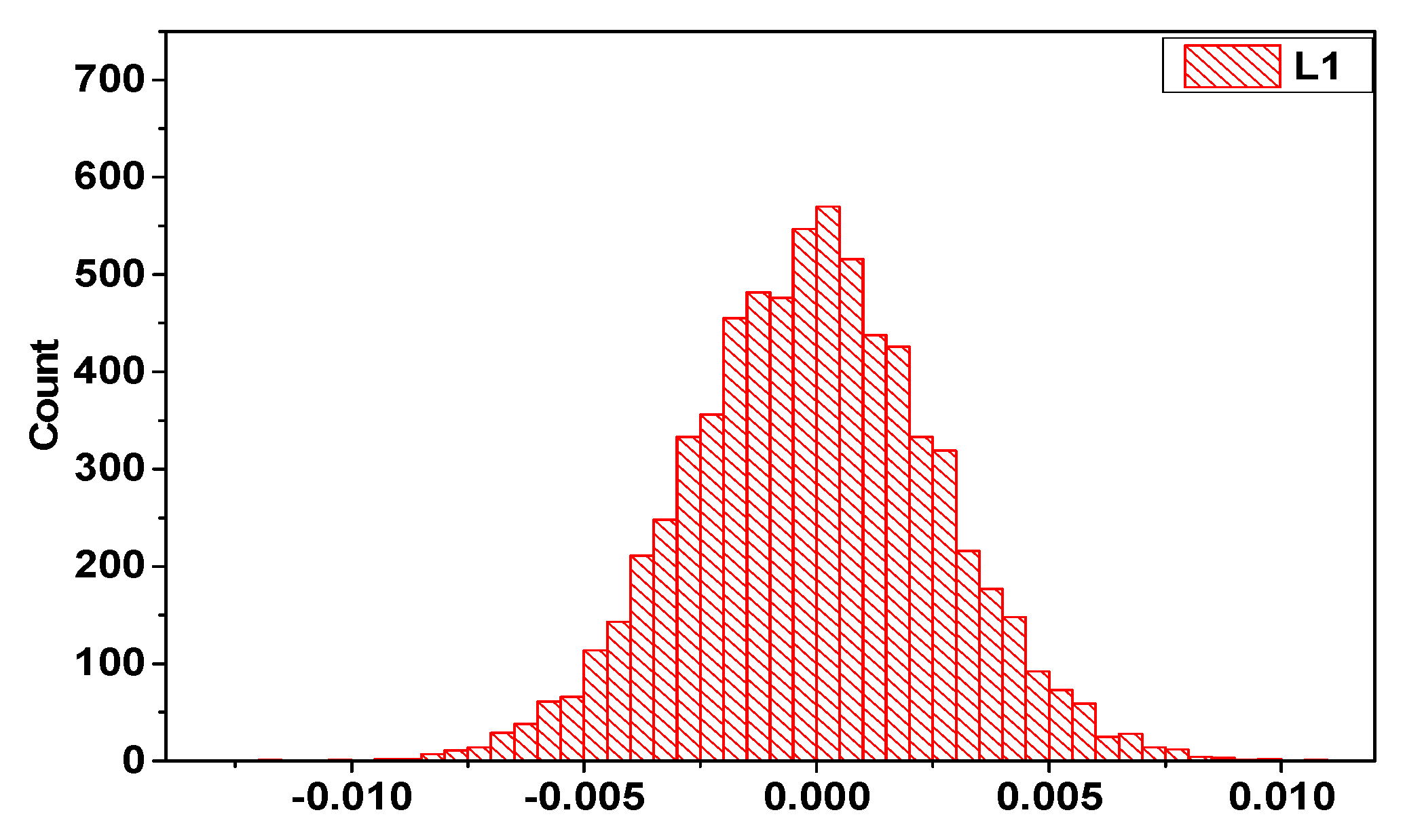
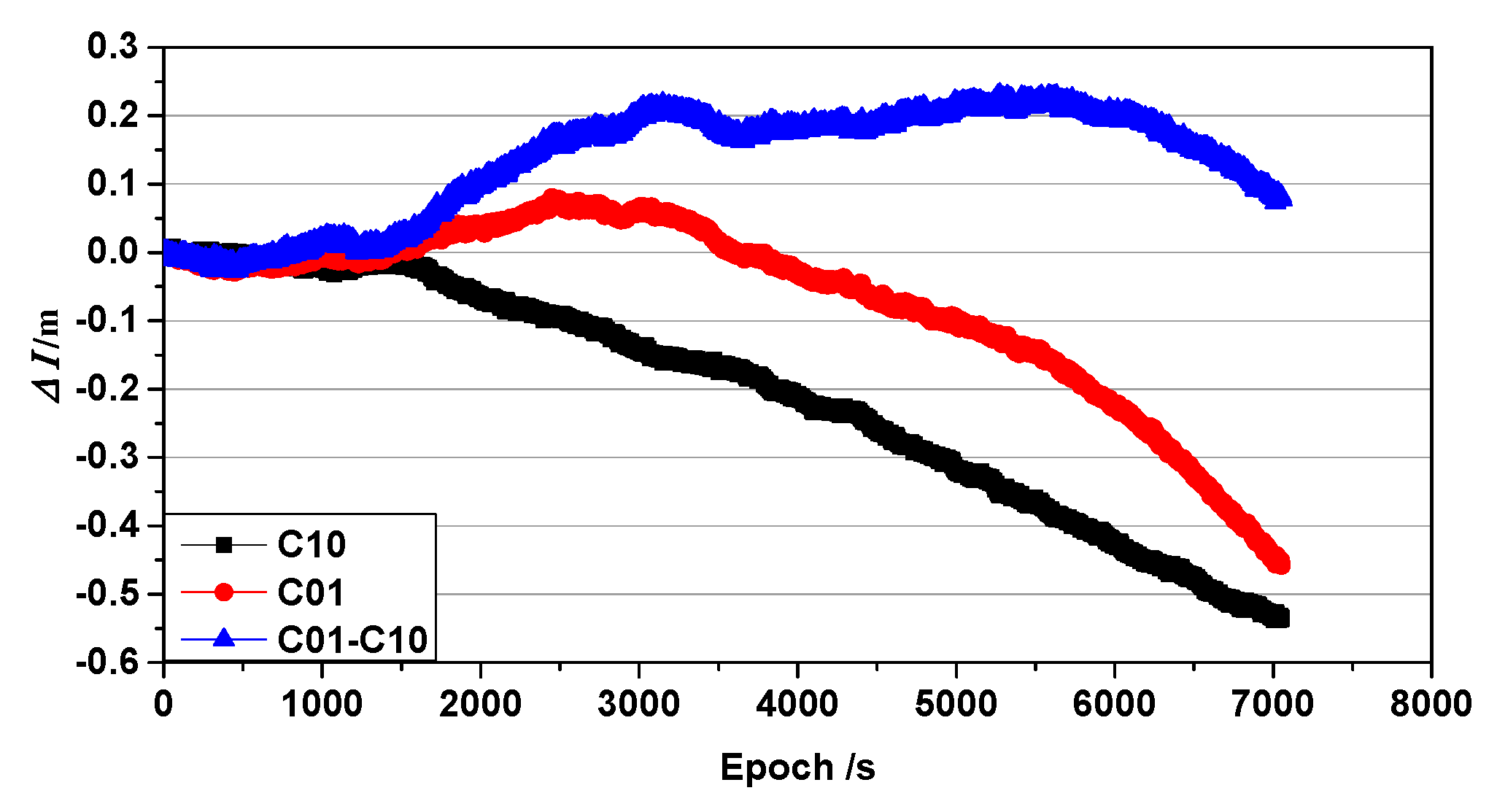


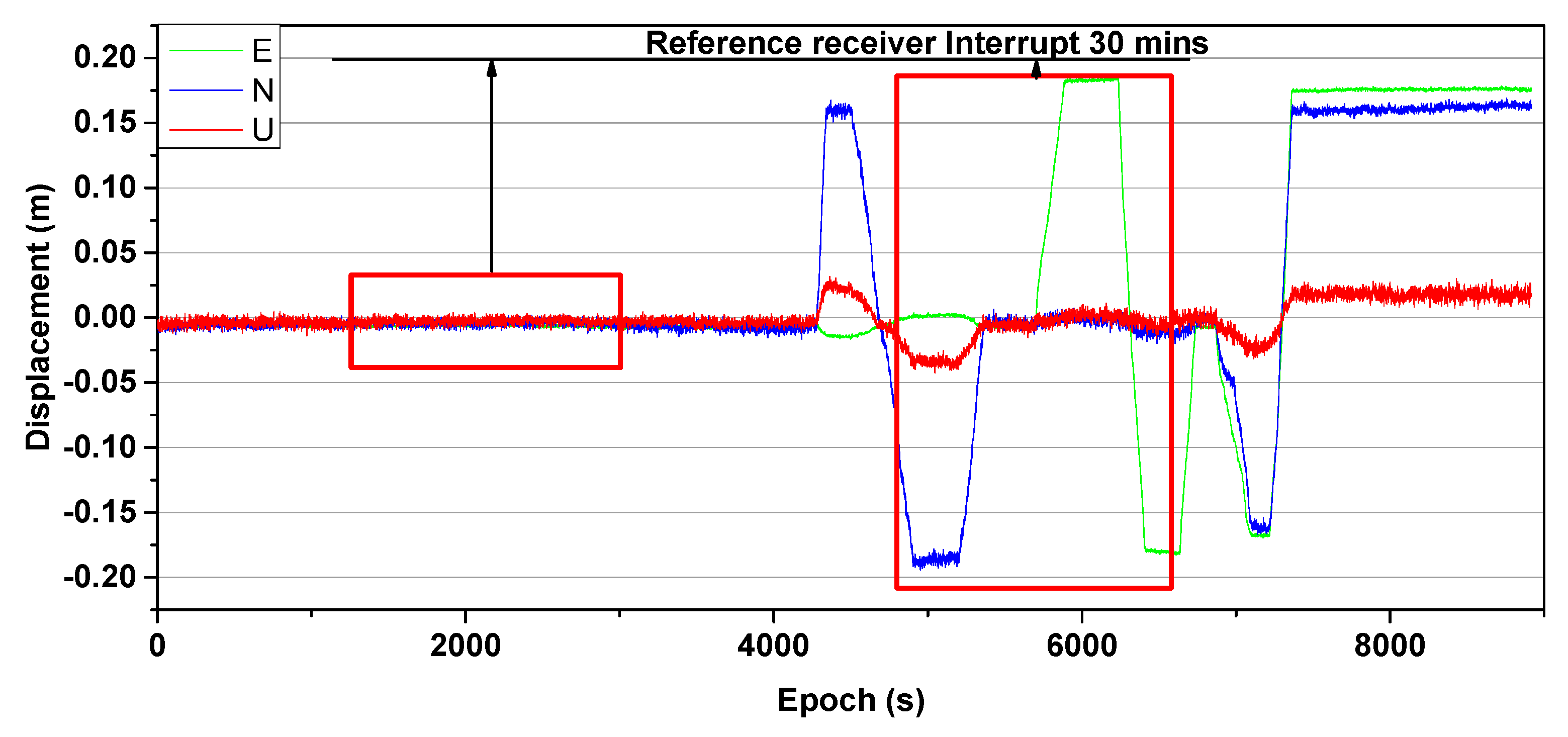
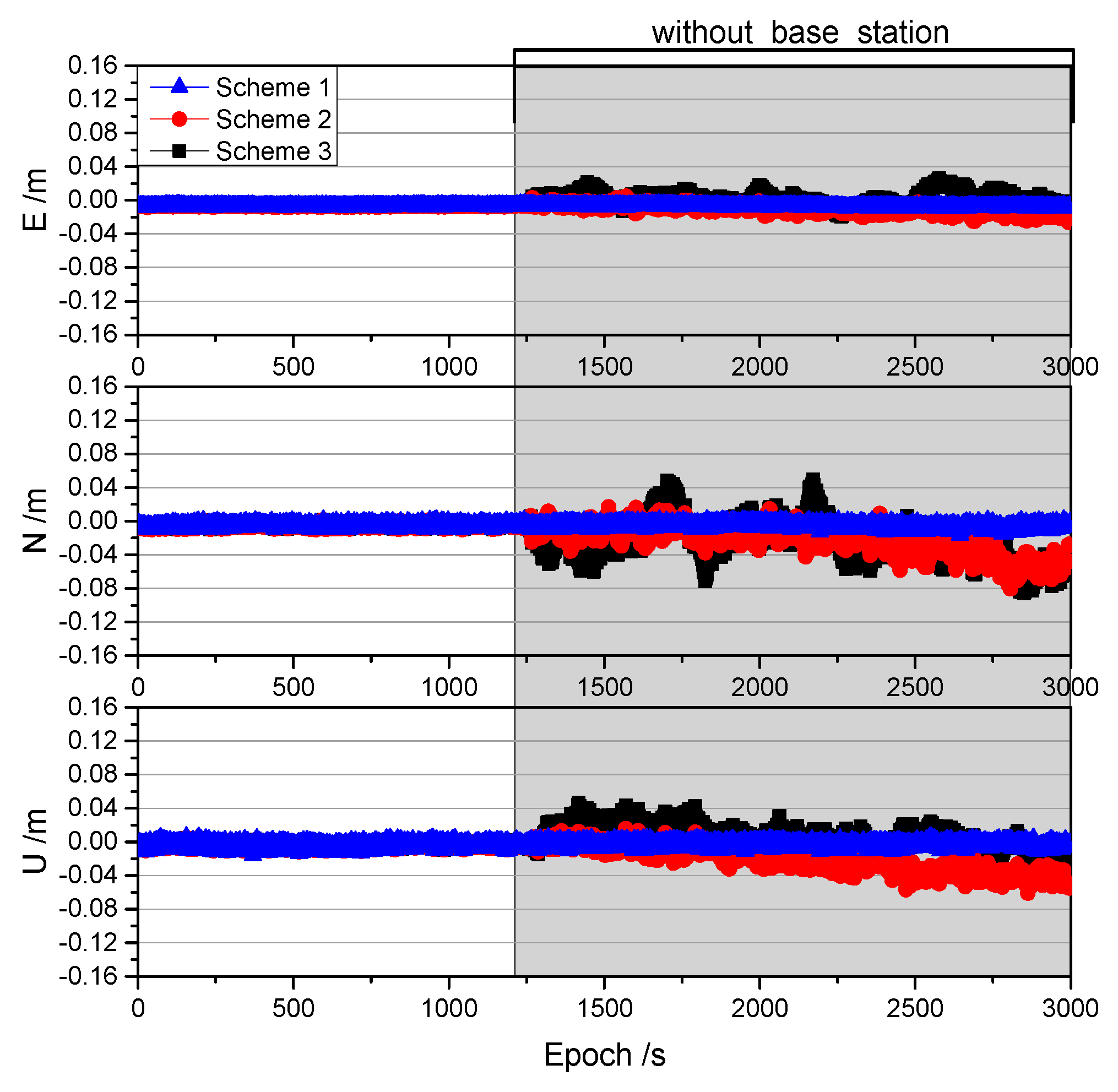
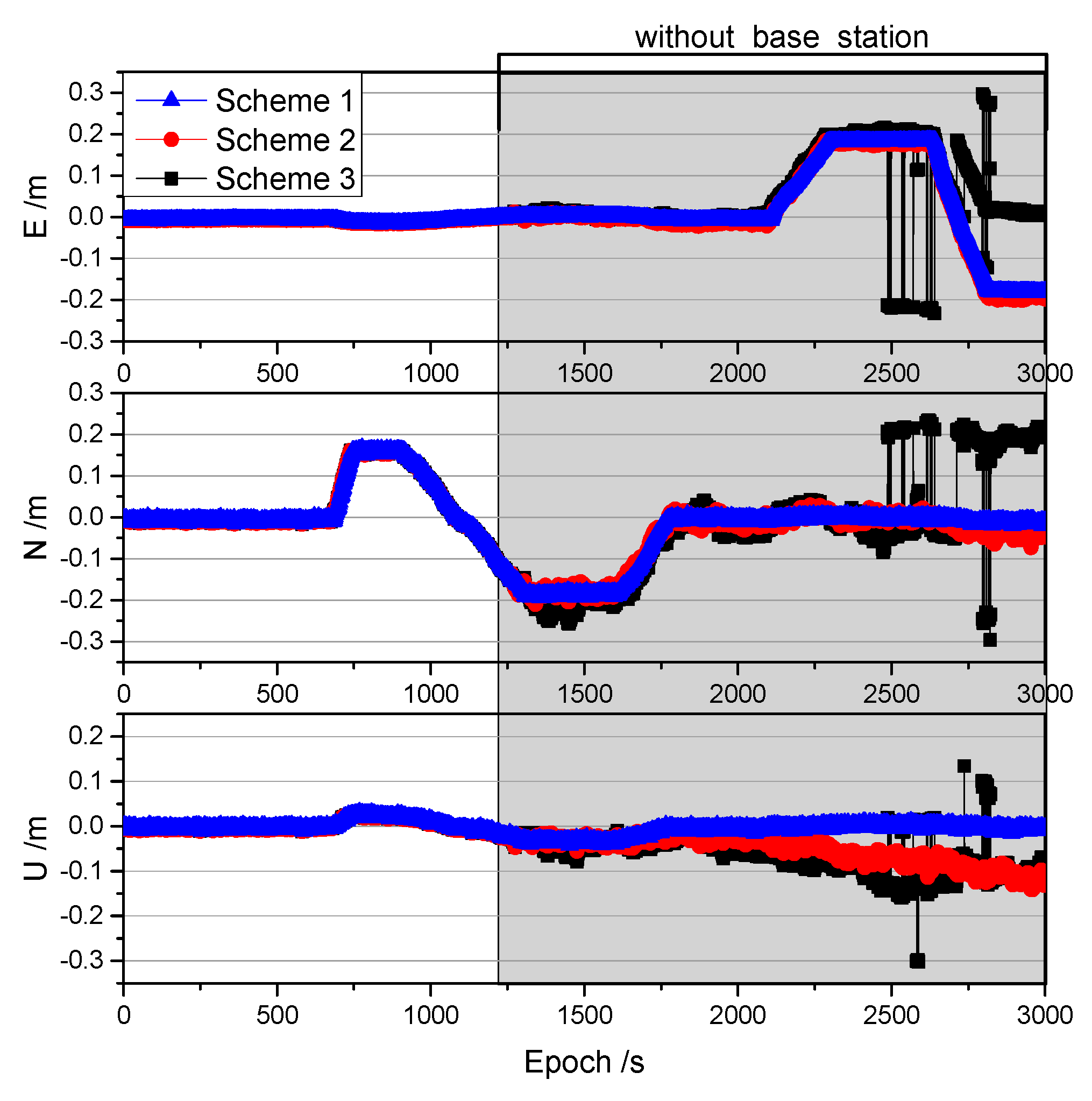

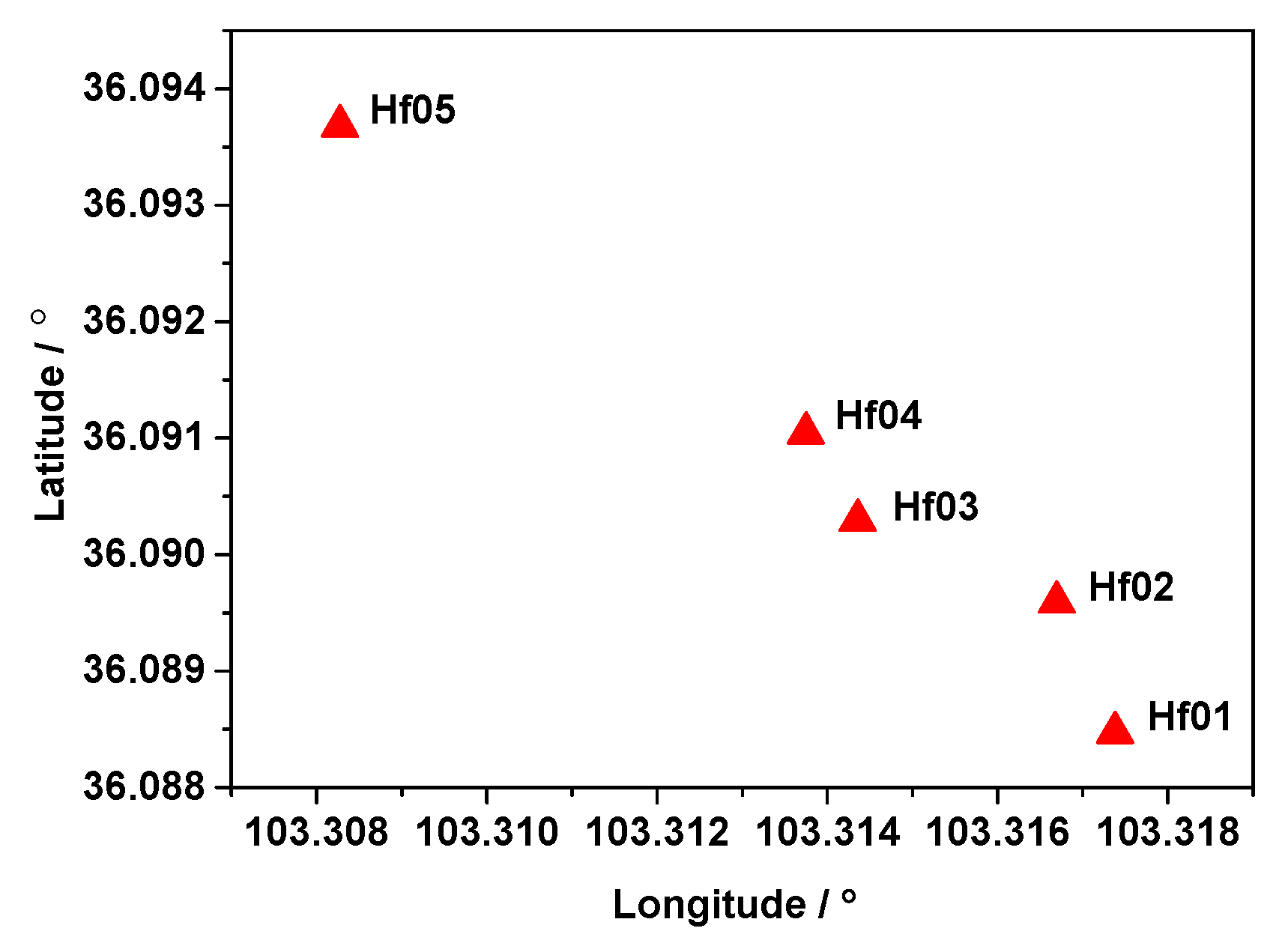

| Time Span of the Interruption (min) | Standard Deviation (m) of Scheme 2 | Standard Deviation (m) of Scheme 3 | ||||
|---|---|---|---|---|---|---|
| E | N | U | E | N | U | |
| 10 | 0.003 | 0.009 | 0.007 | 0.005 | 0.024 | 0.011 |
| 20 | 0.004 | 0.011 | 0.011 | 0.007 | 0.023 | 0.013 |
| 30 | 0.005 | 0.017 | 0.016 | 0.008 | 0.025 | 0.015 |
| Time Span of the Interruption (min) | Standard Deviation (m) of Scheme 2 | Standard Deviation (m) of Scheme 3 | ||||
|---|---|---|---|---|---|---|
| E | N | U | E | N | U | |
| 10 | 0.005 | 0.011 | 0.010 | 0.006 | 0.019 | 0.013 |
| 20 | 0.005 | 0.011 | 0.025 | 0.008 | 0.023 | 0.034 |
| 30 | 0.008 | 0.017 | 0.041 | 0.095 | 0.095 | 0.049 |
| Post-Processing | Real-Time Processing | |||||
|---|---|---|---|---|---|---|
| E | N | U | E | N | U | |
| Static | 30 | 30 | 30 | 30 | 30 | 30 |
| Dynamic | 30 | 30 | 18 | 20 | 20 | 15 |
| Dataset | Stations | Receiver Type | Antenna Type | Length |
|---|---|---|---|---|
| No. 1 | Hf01–Hf02 | UR380 | HG-GOYH7151 | 139 m |
| No. 2 | Hf01–Hf03 | UR380 | HG-GOYH7151 | 225 m |
| No. 3 | Hf01–Hf04 | UR380 | HG-GOYH7151 | 311 m |
| No. 4 | Hf01–Hf05 | UR380 | HG-GOYH7151 | 884 m |
| 15 min | 30 min | |||||
|---|---|---|---|---|---|---|
| E | N | U | E | N | U | |
| No. 1 | 0.014 | 0.019 | 0.029 | 0.019 | 0.019 | 0.035 |
| No. 2 | 0.012 | 0.019 | 0.028 | 0.012 | 0.023 | 0.037 |
| No. 3 | 0.012 | 0.019 | 0.035 | 0.018 | 0.021 | 0.041 |
| No. 4 | 0.013 | 0.018 | 0.029 | 0.021 | 0.022 | 0.041 |
© 2019 by the authors. Licensee MDPI, Basel, Switzerland. This article is an open access article distributed under the terms and conditions of the Creative Commons Attribution (CC BY) license (http://creativecommons.org/licenses/by/4.0/).
Share and Cite
Du, Y.; Huang, G.; Zhang, Q.; Gao, Y.; Gao, Y. A New Asynchronous RTK Method to Mitigate Base Station Observation Outages. Sensors 2019, 19, 3376. https://doi.org/10.3390/s19153376
Du Y, Huang G, Zhang Q, Gao Y, Gao Y. A New Asynchronous RTK Method to Mitigate Base Station Observation Outages. Sensors. 2019; 19(15):3376. https://doi.org/10.3390/s19153376
Chicago/Turabian StyleDu, Yuan, Guanwen Huang, Qin Zhang, Yang Gao, and Yuting Gao. 2019. "A New Asynchronous RTK Method to Mitigate Base Station Observation Outages" Sensors 19, no. 15: 3376. https://doi.org/10.3390/s19153376
APA StyleDu, Y., Huang, G., Zhang, Q., Gao, Y., & Gao, Y. (2019). A New Asynchronous RTK Method to Mitigate Base Station Observation Outages. Sensors, 19(15), 3376. https://doi.org/10.3390/s19153376






